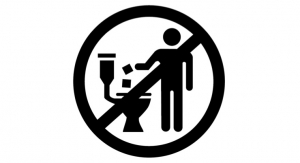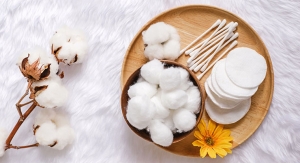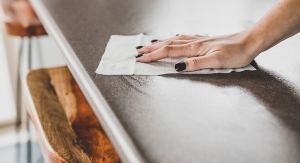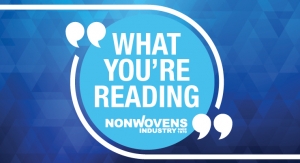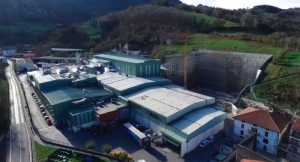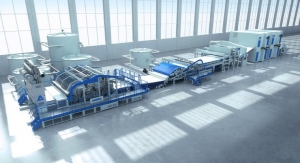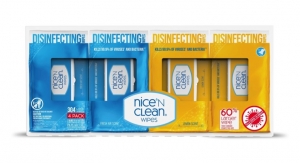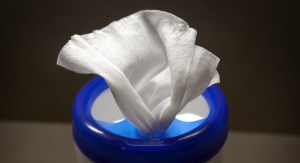Karen McIntyre, Senior Editor02.18.14
The market for flushable wipes continues to grow, fueled by consumers’ need for convenience and cleanliness, in markets ranging from moist toilet tissue to feminine hygiene to adult incontinence to toddler care. According to research conducted ty U.K.-based Smithers Apex, the global market for flushable wipes is 55,000 tons or $1.4 billion.
In recent years, this market has undergone a transformation as problems with sewage systems—although not necessarily caused by wipes—have painted a negative picture of wipes. To combat this industry stakeholders, led by INDA, the North American nonwovens trade association and EDANA, the European Disposables and Nonwovens Association, have established testing criteria to certify products as flushable. Wipes now need to pass third-party testing that proves a product will disperse during the flushing process before it can be marked as flushable. These efforts have stepped up research and development efforts among nonwovens makers and wipes manufacturers.
“Our suppliers are progressive in their outlook on the flushable market and are constantly evolving their technology to improve dispersibility,” says Donna Rippin, category director for personal care marketing at Sheboygan, WI-based Rockline Industries. “Both Rockline and our substrate suppliers share a common interest in protection of the environment and constantly strive for greater sustainability—this drives flushability technology to achieve higher levels of dispersibility. In addition, consumers grow ever more savvy about the impact of consumable products on our planet.”
These efforts have changed the composition of many flushable wipes. Earlier generations of products deemed flushable, like moist toilet tissue, were determined to be flushable because of their size and ability to pass through a septic system but newer generations, subject to testing, have to be truly dispersible based on their composition.
“I think we will see some products disappear from the store shelves,” says Tobias Schäfer of machinery supplier Andritz. “A lot of products will not be able to pass the criteria needed to be labeled flushable according to the latest EDANA/INDA guidelines.”
Nonwovens made with wetlaid/hydroentangled process (wetlace) are leading the way in the development of flushable wet wipes, in particular moist toilet tissue. Andritz technology uses a blend of fibers, always containing pulp plus short cut staple fibers that are about a quarter the length of fibers used in standard spunlace. These shorter fibers offer stability but still disentangle during flush. While pulp does not offer any dimensional stability it adds other attributes like absorbency and biodegradability.
Pulp is added to the wetlace product in varying percentages depending on the needs of the final wipe product. “There is more pulp in flushable wipes, but the problem is pulp offers no wet strength at all,” Schäfer says. “If you compare a standard spunlace with the flushable product, spunlace is normally not flushable but it has the advantages of a good textile appearance, bulkiness and strength. The longer fibers entangle usually better but the product will not breakdown.”
Kimberly-Clark’s airlaid pulp/binder technology, which is used by its external businesses, Suominen’s Hyrdraspun made through a wetlaid-spunlace-thermal bonding products, and Georgia-Pacific/Buckeye’s Airspun non-triggered airlaid nonwovens are the three main substrates used within the wipes market but more technologies are emerging as interest in flushability is expanding.
Last year, Trützschler, a maker of hydrotentanglement lines, and paper specialist Voith Paper developed a wet-in-wet process similar to the Ahlstrom/Suominen approach but without the use of bicomponent fibers for the flushable wipes market. “By carefully choosing raw materials and machine settings, we succeeded in producing nonwoven materials with the desired wet strength,” says Jutta Stehr, marketing manager, Trützchler. “So the unfinished nonwoven only contains fibers. Moreover, these fibers are 100% biodegradable. A high percentage of pulp delivers disintegration, the small amount of regenerated wood cellulosic fibers ensures the wet strength. Our product is the first material which disintegrates in water, is 100% biodegradable, uses low/moderately priced raw materials, has the required wet strength and is drapable and soft.”
From a machinery standpoint, the process relies on Voith’s HydroFormer for web formation and the Trützschler Nonwovens’ AquaJet for web bonding.
In late 2013, the companies announced the technology had passed INDA/EDANA flushability which will help it penetrate the flushable wipes category. Passing these standards prove to the industry that this product is safe to flush.
“Developing standards in this field will help wipe producers, consumers and sewage treatment plants,” Stehr says. “Market success crucially depends on consumer confidence. With the new guidelines only truly flushable wipes will pass the INDA/EDANA test series, all other products must be marked with the do-not-flush sign and will vanish from the market I presume.”
Market Report
According to Rippin, the flushable wipes category has historically been somewhat synonymous with “moist toilet tissue” (MTT) although other product categories are beginning to move toward dispersible substrates such as feminine care and incontinence wipes. These three categories have combined sales of $500 million in the U.S., growing at a healthy rate of 5-10%. Moist toilet tissue dominates, representing $400 million in sales.
The key branded competitors in this space are Procter & Gamble’s Charmin moist toilet tissue (its Always feminine care wipes are made from non-dispersible spunlace material), and Kimberly Clark’s Cottonelle and Scotts wet tissue. Within moist toilet tissue, the Cottonelle brand, which is scheduled to be upgraded in 2014, according to Kimberly-Clark, comprises 65% of the market making it the dollar share leader. Private label is the share leader in unit sales (40%) and has the no. 2 spot in dollar share.
Products come in a nice range of options for the consumer: tubs, refill packs, and large “club box” sizes, and the emergence of more options in dispersable technology has helped grow this category into new areas. “This is the case with fem care wipes,” Rippin says. “Studies have found that consumers flush them anyway. Prevailing spunlace substrate is not flushable, and if they don’t flush them, they would like to have the ability to flush them.”
Rockline offers a full range of national brand equivalent moist toilet tissue wipes including a “pop-up” product packaged in tubs, refill zipper bags, refill/travel soft packs, singles sachets and club boxes. “All of Rockline’s products use a unique dispersible substrate that allows our products to be safely flushed, provided the consumer has a properly maintained household system,” Rippin explains.
Rockline also offers a dispersible version of its feminine wipes which are comparable to P&G’s Always products.
Also expanding its scope in the flushable segment is SCA. The Sweden-based hygiene products manufacturer announced in September 2012 that its Tena flushable wash cloths were certified as flushable. The product, which is 99% biodegradable in addition to being flushable continues to be an important part of the company’s growth strategy.
“These wipes are the only adult-sized product in the category to carry NSF Flushable Product Certification,” says Jessica Lan, skin care brand manager, personal care, North America for SCA. “Obtaining this certification was important to Tena to help validate the high quality of our products and continue SCA’s tradition of innovation and commitment to environmental responsibility. They also feature a 3-in-1 moisturizing formula and are pH balanced to promote skin integrity and skin health. Simply put, Tena Flushable Washcloths are easier on the environment, better for residents and smarter for business.”
Tena, a global leader in adult incontinence is one of SCA’s strongest brands, and also includes personal care wipes and other skin care products that improve lives for customers and consumers. According to Lan, the company has numerous ongoing projects and recently launched several interesting products. “For example, last year Tena released an intimate personal care wipe in France that was very successful. The brand also released the TENA Wet Wash Glove in Europe, which combines comfort and convenience for daily full body cleansing without soap and water,” she says.
What Not To Flush
A big part of industry efforts have centered on on educating consumers what not to flush. Analyses of sewage clogs have shown that flushable wipes only comprise under 10% of the problem but they are receiving a big percentage of the blame. In fact, it is products that should absolutely not be flushed—baby wipes, tissues, napkins and paper towels—that account for the bulk of the problem.
To combat this, the INDA/EDANA flushability task force created a “Do Not Flush” logo to warn consumers not to put these items down the toilet. The logo is a part of an updated Code of Practices within the guidelines. These practices include clearer labeling guidelines that will keep government agencies from blaming the wipes industry for clogging problems.
“There is a potential freight train coming down the tracks targeting all manufacturers and marketers of nonwoven wipe substrates, the converters they sell to, and the wipes marketers who buy from the converters,” says Dave Rousse, president of INDA in describing the legislative challenge facing the industry. “The wastewater treatment industry is blaming the nonwoven wipes industry for the clogging of pumps in their wastewater systems.”
Already, several states including California, Maine and New Jersey have responded to clogging complaints from wastewater treatment system operators by drafting legislation—which varies by state—that would dictate what could be called “flushable” or how wipes should be labeled or both.
“INDA’s efforts, along with EDANA’s in Europe, have temporarily ‘tabled’ most legislation as we advance our Flushability Guidelines and exert an effort to get all members of the wipes supply chain to follow the guidelines and adopt the labeling practices of the accompanying Code of Practice,” Rousse adds. “ Not doing so could create unnecessary burdens for all participants in the wipes market. Unfortunately, not all wipes makers and marketers are INDA/EDANA members, so we need to use additional resources, such as industry press, to get the message to them that not following the guidelines could place their business in danger.”
Rousse adds that studies have shown that wipes that meet the guidelines are not the cause of clogs in pumping stations. Rather, paper towels and other items represent the highest volume of materials found when pumps are unclogged. “We do know that baby wipes and some other personal care wipes, none of which were designed to be flushed, can often get flushed. These products need to display the Do Not Flush logo prescribed in our Code of Practice,” he says.
In addition to the guidelines, industry associations have been working with clean water agencies to reduce the burden of non-flushable disposable products in the wastewater systems. INDA, for its part is working with the National Association of Clean Water Agencies, the Water Environment Federation and the American Public Works Assocaition.
“The problems in the sewer system are caused by the flushing of products that don’t properly break apart in the sewer system—products such as baby wipes, personal care wipes, paper towels, and feminine care products. These products are sometimes disposed of in toilets because of how and where they are used, causing significant economic burdens on local wastewater treatment systems,” says NACWA director of Regulatory Affairs, Cynthia Finley.
INDA has also teamed up with the Maine Wastewater Control Association to educate consumers not to flush baby wipes, which can cause sewer backups into homes and also damage equipment at wastewater treatment facilities, potentially costing hundreds of thousands of dollars in damages.
INDA and MWWCA kicked off this consumer education campaign with a press conference at the Westbrook Treatment Facility in Maine in late January. The consumer education program will cover select areas of Maine through various media outlets, i.e., television, newspapers, social media and direct mail. The consumer education campaign theme is “Save Your Pipes: Don’t Flush Baby Wipes” and will include television commercials featuring a game show titled “What the Flush?!?” airing in select areas of Maine.
“The goal of this consumer education program is to raise awareness and change consumer behavior,” Rousse says. “Consumers may not be aware that simply because the product disappears down the toilet, it doesn’t mean that it is a flushable product.”
Consumer education, in fact, is huge part of the INDA/EDANA flushability guidelines. The third generation of these guidelines were announced in June 2013 at the World of Wipes conference.
The organizations first began working on flushability guidelines in 2004 with a special flushability taskforce featuring 31 companies. The first set of guidelines were released in 2008 and updated in 2009. Since then, INDA and EDANA have been collaborating with the wastewater industry to advance the shared objective of reducing the amount of non-flushable material in the wastewater stream.
The new third edition streamlines and improves on previous editions. For example, it replaces the tiered approach of 23 tests with a more transparent, rigorous straight-line assessment using only seven core tests, which all must be passed to support a flushable claim. Within the framework of the third edition guidelines there is a decision tree with simple yes/no answers used to determine if a product can make a flushable claim or if it needs to display the Do Not Flush logo. It also addresses a wastewater infrastructure concern with the inclusion of a Municipal Sewage Pump Test and a Disintegration Test.
In recent years, this market has undergone a transformation as problems with sewage systems—although not necessarily caused by wipes—have painted a negative picture of wipes. To combat this industry stakeholders, led by INDA, the North American nonwovens trade association and EDANA, the European Disposables and Nonwovens Association, have established testing criteria to certify products as flushable. Wipes now need to pass third-party testing that proves a product will disperse during the flushing process before it can be marked as flushable. These efforts have stepped up research and development efforts among nonwovens makers and wipes manufacturers.
“Our suppliers are progressive in their outlook on the flushable market and are constantly evolving their technology to improve dispersibility,” says Donna Rippin, category director for personal care marketing at Sheboygan, WI-based Rockline Industries. “Both Rockline and our substrate suppliers share a common interest in protection of the environment and constantly strive for greater sustainability—this drives flushability technology to achieve higher levels of dispersibility. In addition, consumers grow ever more savvy about the impact of consumable products on our planet.”
These efforts have changed the composition of many flushable wipes. Earlier generations of products deemed flushable, like moist toilet tissue, were determined to be flushable because of their size and ability to pass through a septic system but newer generations, subject to testing, have to be truly dispersible based on their composition.
“I think we will see some products disappear from the store shelves,” says Tobias Schäfer of machinery supplier Andritz. “A lot of products will not be able to pass the criteria needed to be labeled flushable according to the latest EDANA/INDA guidelines.”
Nonwovens made with wetlaid/hydroentangled process (wetlace) are leading the way in the development of flushable wet wipes, in particular moist toilet tissue. Andritz technology uses a blend of fibers, always containing pulp plus short cut staple fibers that are about a quarter the length of fibers used in standard spunlace. These shorter fibers offer stability but still disentangle during flush. While pulp does not offer any dimensional stability it adds other attributes like absorbency and biodegradability.
Pulp is added to the wetlace product in varying percentages depending on the needs of the final wipe product. “There is more pulp in flushable wipes, but the problem is pulp offers no wet strength at all,” Schäfer says. “If you compare a standard spunlace with the flushable product, spunlace is normally not flushable but it has the advantages of a good textile appearance, bulkiness and strength. The longer fibers entangle usually better but the product will not breakdown.”
Kimberly-Clark’s airlaid pulp/binder technology, which is used by its external businesses, Suominen’s Hyrdraspun made through a wetlaid-spunlace-thermal bonding products, and Georgia-Pacific/Buckeye’s Airspun non-triggered airlaid nonwovens are the three main substrates used within the wipes market but more technologies are emerging as interest in flushability is expanding.
Last year, Trützschler, a maker of hydrotentanglement lines, and paper specialist Voith Paper developed a wet-in-wet process similar to the Ahlstrom/Suominen approach but without the use of bicomponent fibers for the flushable wipes market. “By carefully choosing raw materials and machine settings, we succeeded in producing nonwoven materials with the desired wet strength,” says Jutta Stehr, marketing manager, Trützchler. “So the unfinished nonwoven only contains fibers. Moreover, these fibers are 100% biodegradable. A high percentage of pulp delivers disintegration, the small amount of regenerated wood cellulosic fibers ensures the wet strength. Our product is the first material which disintegrates in water, is 100% biodegradable, uses low/moderately priced raw materials, has the required wet strength and is drapable and soft.”
From a machinery standpoint, the process relies on Voith’s HydroFormer for web formation and the Trützschler Nonwovens’ AquaJet for web bonding.
In late 2013, the companies announced the technology had passed INDA/EDANA flushability which will help it penetrate the flushable wipes category. Passing these standards prove to the industry that this product is safe to flush.
“Developing standards in this field will help wipe producers, consumers and sewage treatment plants,” Stehr says. “Market success crucially depends on consumer confidence. With the new guidelines only truly flushable wipes will pass the INDA/EDANA test series, all other products must be marked with the do-not-flush sign and will vanish from the market I presume.”
Market Report
According to Rippin, the flushable wipes category has historically been somewhat synonymous with “moist toilet tissue” (MTT) although other product categories are beginning to move toward dispersible substrates such as feminine care and incontinence wipes. These three categories have combined sales of $500 million in the U.S., growing at a healthy rate of 5-10%. Moist toilet tissue dominates, representing $400 million in sales.
The key branded competitors in this space are Procter & Gamble’s Charmin moist toilet tissue (its Always feminine care wipes are made from non-dispersible spunlace material), and Kimberly Clark’s Cottonelle and Scotts wet tissue. Within moist toilet tissue, the Cottonelle brand, which is scheduled to be upgraded in 2014, according to Kimberly-Clark, comprises 65% of the market making it the dollar share leader. Private label is the share leader in unit sales (40%) and has the no. 2 spot in dollar share.
Products come in a nice range of options for the consumer: tubs, refill packs, and large “club box” sizes, and the emergence of more options in dispersable technology has helped grow this category into new areas. “This is the case with fem care wipes,” Rippin says. “Studies have found that consumers flush them anyway. Prevailing spunlace substrate is not flushable, and if they don’t flush them, they would like to have the ability to flush them.”
Rockline offers a full range of national brand equivalent moist toilet tissue wipes including a “pop-up” product packaged in tubs, refill zipper bags, refill/travel soft packs, singles sachets and club boxes. “All of Rockline’s products use a unique dispersible substrate that allows our products to be safely flushed, provided the consumer has a properly maintained household system,” Rippin explains.
Rockline also offers a dispersible version of its feminine wipes which are comparable to P&G’s Always products.
Also expanding its scope in the flushable segment is SCA. The Sweden-based hygiene products manufacturer announced in September 2012 that its Tena flushable wash cloths were certified as flushable. The product, which is 99% biodegradable in addition to being flushable continues to be an important part of the company’s growth strategy.
“These wipes are the only adult-sized product in the category to carry NSF Flushable Product Certification,” says Jessica Lan, skin care brand manager, personal care, North America for SCA. “Obtaining this certification was important to Tena to help validate the high quality of our products and continue SCA’s tradition of innovation and commitment to environmental responsibility. They also feature a 3-in-1 moisturizing formula and are pH balanced to promote skin integrity and skin health. Simply put, Tena Flushable Washcloths are easier on the environment, better for residents and smarter for business.”
Tena, a global leader in adult incontinence is one of SCA’s strongest brands, and also includes personal care wipes and other skin care products that improve lives for customers and consumers. According to Lan, the company has numerous ongoing projects and recently launched several interesting products. “For example, last year Tena released an intimate personal care wipe in France that was very successful. The brand also released the TENA Wet Wash Glove in Europe, which combines comfort and convenience for daily full body cleansing without soap and water,” she says.
What Not To Flush
A big part of industry efforts have centered on on educating consumers what not to flush. Analyses of sewage clogs have shown that flushable wipes only comprise under 10% of the problem but they are receiving a big percentage of the blame. In fact, it is products that should absolutely not be flushed—baby wipes, tissues, napkins and paper towels—that account for the bulk of the problem.
To combat this, the INDA/EDANA flushability task force created a “Do Not Flush” logo to warn consumers not to put these items down the toilet. The logo is a part of an updated Code of Practices within the guidelines. These practices include clearer labeling guidelines that will keep government agencies from blaming the wipes industry for clogging problems.
“There is a potential freight train coming down the tracks targeting all manufacturers and marketers of nonwoven wipe substrates, the converters they sell to, and the wipes marketers who buy from the converters,” says Dave Rousse, president of INDA in describing the legislative challenge facing the industry. “The wastewater treatment industry is blaming the nonwoven wipes industry for the clogging of pumps in their wastewater systems.”
Already, several states including California, Maine and New Jersey have responded to clogging complaints from wastewater treatment system operators by drafting legislation—which varies by state—that would dictate what could be called “flushable” or how wipes should be labeled or both.
“INDA’s efforts, along with EDANA’s in Europe, have temporarily ‘tabled’ most legislation as we advance our Flushability Guidelines and exert an effort to get all members of the wipes supply chain to follow the guidelines and adopt the labeling practices of the accompanying Code of Practice,” Rousse adds. “ Not doing so could create unnecessary burdens for all participants in the wipes market. Unfortunately, not all wipes makers and marketers are INDA/EDANA members, so we need to use additional resources, such as industry press, to get the message to them that not following the guidelines could place their business in danger.”
Rousse adds that studies have shown that wipes that meet the guidelines are not the cause of clogs in pumping stations. Rather, paper towels and other items represent the highest volume of materials found when pumps are unclogged. “We do know that baby wipes and some other personal care wipes, none of which were designed to be flushed, can often get flushed. These products need to display the Do Not Flush logo prescribed in our Code of Practice,” he says.
In addition to the guidelines, industry associations have been working with clean water agencies to reduce the burden of non-flushable disposable products in the wastewater systems. INDA, for its part is working with the National Association of Clean Water Agencies, the Water Environment Federation and the American Public Works Assocaition.
“The problems in the sewer system are caused by the flushing of products that don’t properly break apart in the sewer system—products such as baby wipes, personal care wipes, paper towels, and feminine care products. These products are sometimes disposed of in toilets because of how and where they are used, causing significant economic burdens on local wastewater treatment systems,” says NACWA director of Regulatory Affairs, Cynthia Finley.
INDA has also teamed up with the Maine Wastewater Control Association to educate consumers not to flush baby wipes, which can cause sewer backups into homes and also damage equipment at wastewater treatment facilities, potentially costing hundreds of thousands of dollars in damages.
INDA and MWWCA kicked off this consumer education campaign with a press conference at the Westbrook Treatment Facility in Maine in late January. The consumer education program will cover select areas of Maine through various media outlets, i.e., television, newspapers, social media and direct mail. The consumer education campaign theme is “Save Your Pipes: Don’t Flush Baby Wipes” and will include television commercials featuring a game show titled “What the Flush?!?” airing in select areas of Maine.
“The goal of this consumer education program is to raise awareness and change consumer behavior,” Rousse says. “Consumers may not be aware that simply because the product disappears down the toilet, it doesn’t mean that it is a flushable product.”
Consumer education, in fact, is huge part of the INDA/EDANA flushability guidelines. The third generation of these guidelines were announced in June 2013 at the World of Wipes conference.
The organizations first began working on flushability guidelines in 2004 with a special flushability taskforce featuring 31 companies. The first set of guidelines were released in 2008 and updated in 2009. Since then, INDA and EDANA have been collaborating with the wastewater industry to advance the shared objective of reducing the amount of non-flushable material in the wastewater stream.
The new third edition streamlines and improves on previous editions. For example, it replaces the tiered approach of 23 tests with a more transparent, rigorous straight-line assessment using only seven core tests, which all must be passed to support a flushable claim. Within the framework of the third edition guidelines there is a decision tree with simple yes/no answers used to determine if a product can make a flushable claim or if it needs to display the Do Not Flush logo. It also addresses a wastewater infrastructure concern with the inclusion of a Municipal Sewage Pump Test and a Disintegration Test.



